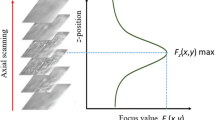Abstract
The in situ geometry measurement of microstructures in the laser chemical machining (LCM) manufacturing process places high demands on measurement systems because the specimen is submerged in a closed fluid circuit. The steep slopes of the manufactured micro-components and the general lack of accessibility hinder the use of standard techniques such as tactile measurement or conventional confocal microscopy. A technique based on confocal fluorescence microscopy shows promise for increasing the measurability on metallic surfaces with large curvatures. By applying an intensely scattering fluorescent coating to the specimen, the surface position can be determined by the change in fluorescence signal at the boundary between specimen and coating. In contrast to the currently tested thin coatings (\(< 100\, \upmu \hbox {m}\)) the measurements in layers thicker than \( 1\, \hbox {mm}\), as required for in situ application at the LCM process, show distinct dependencies on the fluorescent medium in terms of concentration and index of refraction. Hence, a fundamentally different signal evaluation approach based on a physical model of the fluorescence signal is needed to extract the surface position information from the detected fluorescence intensity signal. For the purpose of validation, the measurement of a step geometry is performed under the condition of a thick fluid layer and referenced with a tactile measurement. As a result, the model-based approach is shown to be suitable to detect the geometry parameter step height with an uncertainty of \( 8.8\, \upmu \hbox {m}\) for a step submerged in a fluid layer with a thickness of \(2.3\, \hbox {mm}\).








Similar content being viewed by others
References
Ahmed N, Darwish S, Alahmari AM (2016) Laser ablation and laser-hybrid ablation processes: a review. Mater Manuf Process 31(9):1121–1142
De Silva A, Pajak P, McGeough J, Harrison D (2011) Thermal effects in laser assisted jet electrochemical machining. CIRP Ann Manuf Technol 60:243–246
Gerhard C, Vollertsen F (2010) Limits for interferometric measurements on rough surfaces in streaming inhomogeneous media. Prod Eng Res Dev 4(2–3):141–146
Hansen H, Carneiro K, Haitjema H, De Chiffre L (2006) Dimensional micro and nano metrology. CIRP Ann 55:721–743
Liu J, Liu C, Tan J, Yang B, Wilson T (2016) Super-aperture metrology: overcoming a fundamental limit in imaging smooth highly curved surfaces. J Microsc 261(3):300–306
Malzer W, KanngieSSer B (2005) A model for the confocal volume of 3d micro x-ray fluorescence spectrometer. Spectrochim Acta Part B At Spectrosc 60(9–10):1334–1341
Maruno K, Michihata M, Mizutani Y, Takaya Y (2016) Fundamental study on novel on-machine measurement method of a cutting tool edge profile with a fluorescent confocal microscopy. Int J Autom Technol 10(1):106–113
Michihata M, Fukui A, Hayashi T, Takaya Y (2014) Sensing a vertical surface by measuring a fluorescence signal using a confocal optical system. Meas Sci Technol 25(6):064004
Pajak P, Desilva A, Harrison D, Mcgeough J (2006) Precision and efficiency of laser assisted jet electrochemical machining. Precis Eng 30(3):288–298
Petersen NO (2017) Foundations for nanoscience and nanotechnology. CRC Press, Boca Raton
Philipp K, Smolarski A, Koukourakis N, Fischer A, Sturmer M, Wallrabe U, Czarske JW (2016) Volumetric HiLo microscopy employing an electrically tunable lens. Opt Express 24:15029–15041
Qin Y (ed) (2015) Chapter 1 - overview of micro-manufacturing. In: Micromanufacturing engineering and technology. Micro and nano technologies, 2nd edn. William Andrew Publishing, Boston, pp 1–33. https://doi.org/10.1016/B978-0-323-31149-6.00001-3
Rüttinger S, Buschmann V, Krämner B (2008) Comparison and accuracy of methods to determine the confocal volume for quantitative fluorescence correlation spectroscopy. J Microsc 232:343–352
Stephen A, Vollertsen F (2010) Mechanisms and processing limits in laser thermochemical machining. CIRP Ann Manuf Technol 59(1):251–254
Takaya Y, Maruno K, Michihata M, Mizutani Y (2016) Measurement of a tool wear profile using confocal fluorescence microscopy of the cutting fluid layer. CIRP Ann Manuf Technol 65(1):467–470
Visser T (1992) Refractive index and axial distance measurements in 3-d microscopy. Optik 90:17–19
Wang K, Wu J, Day R, Kirk TB (2012) Utilizing confocal microscopy to measure refractive index of articular cartilage. J Microsc 248(3):281–291
Zhang P, von Freyberg A, Fischer A (2017) Closed-loop quality control system for laser chemical machining in metal micro-production. Int J Adv Manuf Technol 93(9–12):3693–3703
Zhang P, Goch G (2015) A quality controlled laser-chemical process for micro metal machining. Prod Eng 9(5–6):577–583
Acknowledgements
The authors gratefully acknowledge the financial support by the Deutsche Forschungsgemeinschaft (DFG, German Research Foundation) for subprojects A5 & B9 within the SFB 747 (Collaborative Research Center) “Mikrokaltumformen – Prozesse, Charakterisierung, Optimierung.”
Author information
Authors and Affiliations
Corresponding author
Rights and permissions
About this article
Cite this article
Mikulewitsch, M., Auerswald, M.M., von Freyberg, A. et al. Geometry Measurement of Submerged Metallic Micro-Parts Using Confocal Fluorescence Microscopy. Nanomanuf Metrol 1, 171–179 (2018). https://doi.org/10.1007/s41871-018-0019-6
Received:
Accepted:
Published:
Issue Date:
DOI: https://doi.org/10.1007/s41871-018-0019-6




